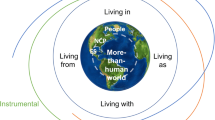Abstract
The effects of the flood control project of the Kakehashi River on the heritage value of Komatsu Tenmangu (a Shinto shrine) in Japan are analyzed in terms of Amartya Sen’s capability approach. The shrine was founded in 1657, and its main buildings are nationally designated “important cultural properties” such that its historical location is to be conserved by an embankment encircling the shrine. Qualitative and reflective exercises of the shrine’s functionings revealed a new heritage value in which intangible cultural heritage of traditional ritual and currently forgotten memories of political thought were embodied in newly found tangible heritage such as the consistent positional patterns of the shrine buildings in relation to the winter solstice sunrise and to the 15-story stone tower. The article also clarifies the rationale for an adequate buffer zone around a historic place by explaining how the risk of external diseconomy inflicted on the shrine entity’s capability was dealt with in a precautionary way.
Similar content being viewed by others
References
Agency for Cultural Affairs (2007) Preserving and utilizing cultural properties. http://www.bunka.go.jp/english/pdf/04_04-47-64p.pdf. Cited 25 July 2007
Canadian Register of Historic Places (CRHP) (2006) What are the eligibility criteria for listing a historic place on the Canadian Register? http://www.historicplaces.ca/rep-reg/eligibility-admissibilite_e.aspx. Cited 25 July 2007
Deacon H, Mrubata M, Dondolo L, Prosalendis S (2004) The subtle power of intangible heritage: legal and financial instruments for safeguarding intangible heritage. Human Sciences Research Council, Cape Town
Hiraizumi K (1997) The story of Japan, vol 1. Seisei Kikaku, Ise-shi, Japan
Honda M (1982) Komatsu Tenmangu Engi (in Japanese), In: Komatsu Tenmangu-shi, Komatsu Ten-mangu Shrine Office, Komatsu, pp 59–62
Intergovernmental Committee for the Protection of the World Cultural and Natural Heritage (1992) Operational guidelines for the implementation of the world heritage value. http://whc.unesco.org/archiv/opguide92.pdf. Cited 25 July 2007
Kuroiwa S (1991) Meaning of fifteen-storied stone tower (in Japanese). Komatsu Tenmangu Dayori 7:15–20
Legge J (1991) The Chinese classics, vol 3 (the Shoo King or the book of historical documents). SMC, Taipei
Naito A, Hozumi K (2003) Edo, the city that became Tokyo: an illustrated history. Kodansha, Tokyo
Nakagawa T, Kitabatake Y, Miya S, Kuroiwa S, Kitabatake N (1996) A case study of flood control schemes for the Kakehashi river and their socio-cultural consequences. International Journal of Sustainable Development and World Ecology 3:47–56
Nakanishi T (1984) Tou no Tabi (in Japanese). Undo-Do, Kyoto
National Astronomical Observatory of Japan (2005) Koyomi-keisan-situ of Tenmon Jyouhou Center. http://www.nao.ac.jp/koyomi/. Cited 25 August 2005
Ogura M (1986) Komatsu Tenmangu and religion (in Japanese). In: Kaga Komatsu Tenmangu To Kakehashi-gawa. KomatsuTenmangu Tou Senmon Chousakai, Komatsushi Kyouiku Iinkai, Komatsu-shi, pp 145–182
Sekido S (1986) Stronghold and geology of Komatsu Tenmangu and its surroundings (in Japanese). In: Kaga Komatsu Tenmangu To Kakehashi-gawa. KomatsuTenmangu Tou Senmon Chousakai, Komatsushi Kyouiku Iinkai, Komatsushi, pp 305–340
Sen A (1980) Equality of what? In: McMurrin S (ed) Tanner lectures on human values. Cambridge University Press; reprinted in Sen AK (1982) Choice, welfare, and measurement. Harvard University Press, Cambridge, MA, pp 353–369
Sen A (1987) The standard of living: Lecture II, lives and capabilities. In Hawthorn G (ed.) The Standard of Living, Cambridge University Press, pp 20–38
Sen A (1993) Capability and well-being. In: Nussbaum MC, Sen A (eds) The quality of life. Clarendon, Oxford, pp 30–53
Sen A (1995) Environmental evaluation and social choice. The Japanese Economic Review 46:2 -37
Sen A (1999) Commodities and capabilities, Oxford University Press, New Delhi
Shigaken Kikakubu (1982) Basic survey for landscape preservation of the shrine forests (in Japanese). (Shiga Prefecture Planning Department)
Shrine Office of Komatsu Tenmangu (2006) Characteristics of shrine location and building layouts and their relations with Komatsu Castle (in Japanese). Komatsu Tenmangu Dayori. 22:12–24
Tii A (1986) Urban space and social environment concerning Komatsu Tenmangu (in Japanese). In: Kaga Komatsu Tenmangu To Kakehashi-gawa. KomatsuTenmangu Tou Senmon Chousakai, Komatsushi Kyouiku Iinkai, Komatsu City, pp 183–258
Tobita M (2002) International terrestrial reference frames and transformation of axes (in Japanese). Nihon-Sokuryo-Kyokai, Tokyo
Tomita K (1799) Komatsu-jyou narabini Mimyoukou Yourou Igo Jijyou (Conditions of Maeda Toshitsune’s retirement years in Komatsu Castle) (in Japanese). Reproduced in Tomita K (1884) Sanshushi, vol 3. Ekichi-kan, Kanazawa
Uchida M (1975) Nihon Rekijitsu Genten (in Japanese). Yuzankaku-shuppan, Tokyo
Williamson RA (1984) Living the sky: the cosmos of the American Indian. University of Oklahoma Press, Norman
Yoke HP (1985) Li, Qi and Shu: an introduction to science and civilization in China. Hong Kong University Press, Hong Kong
Author information
Authors and Affiliations
About this article
Cite this article
Kitabatake, Y. Sen’s capability approach applied to the identification of new heritage value: empirical study on the effects of flood control project. Environ Econ Policy Stud 8, 295–313 (2007). https://doi.org/10.1007/BF03353962
Received:
Accepted:
Published:
Issue Date:
DOI: https://doi.org/10.1007/BF03353962




